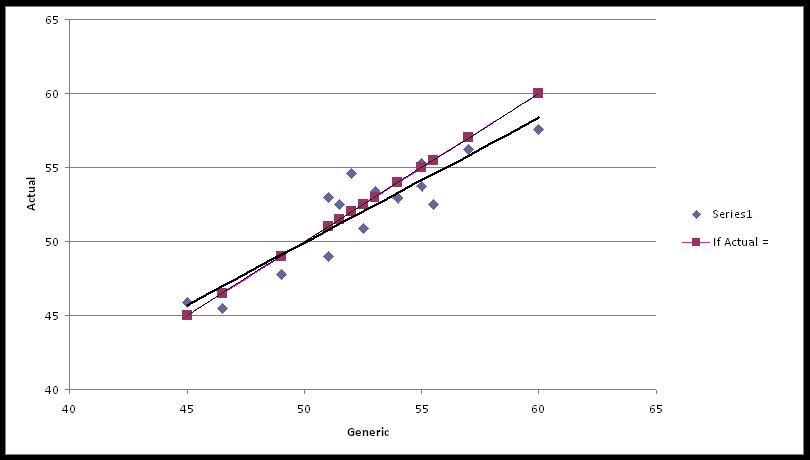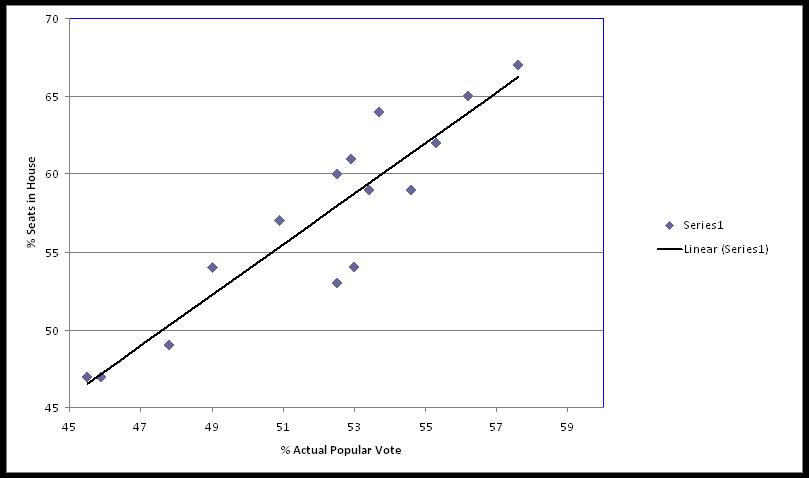With last-minute news reports suggesting that Speaker Boehner does not yet have the votes to pass his deficit reduction bill in the House, I thought it might be worth looking more closely at who the potential Republican “no” votes are. Assuming the House leadership gets no Democratic support, Boehner cannot afford to lose more than 23 Republicans. According to the Hill, there are already 25 “no” or “leaning no” votes, which may explain why Boehner is apparently pushing the vote back until later this evening.
Who are the “no” votes? Here’s a chart, courtesy of Anna Esten, based on the Hill’s latest whip count, summarizing some district and voting related facts for 22 of the declared “no” votes. I’ve arrayed hem in ascending order based on the percentage of the vote Barack Obama received in their district in 2008.
| Representative | District | %vote | %district vote Obama in 2008 | Voting Ideology Rank | |
| Graves, Tom | GA-9 |
100 |
24 |
4th most conservative | |
| Chaffetz, Jason | UT-3 |
87 |
29 |
52nd most conservative | |
| Huelskamp, Tim | KS-1 |
73.8 |
30 |
56th most conservative | |
| Gohmert, Louie | TX-1 |
90 |
31 |
116th most conservatve | |
| Gingrey, Phil | GA-11 |
100 |
33 |
62nd most conservative | |
| Paul, Ron | TX-14 |
76 |
33 |
216th most conservative | |
| Duncan, Jeff | SC-3 |
63 |
34 |
7th most conservative | |
| Broun, Paul | GA-10 |
67 |
38 |
24th most conservative | |
| Flake, Jeff | AZ-6 |
67 |
38 |
33rd most conservative | |
| Gowdy, Trey | SC-4 |
64 |
38 |
2ndmost conservative | |
| Jordan, Jim | OH-4 |
72 |
38 |
1st most conservative | |
| Harris, Andy | MD-1 |
54.6 |
40 |
191st most conservative | |
| Mack, Connie | FL-14 |
69 |
42 |
38th most conservative | |
| Akin, Todd | MO-2 |
67.9 |
44 |
76th most conservative | |
| Gosar, Paul | AZ-1 |
50 |
44 |
124th most conservative | |
| King, Steve | IA-5 |
66 |
44 |
221st most conservative | |
| Bachmann, Michele | MN-6 |
52.5 |
45 |
89th most conservative | |
| Mulvaney, Mick | SC-5 |
55 |
45 |
40th most conservative | |
| Southerland, Steve | FL-2 |
54 |
45 |
30th most conservative | |
| Ross, Dennis | FL-12 |
48 |
48 |
19th most conservative | |
| Amash, Justin | MI-3 |
59.7 |
49 |
139th most conservative | |
| Walsh, Joe | IL-8 |
49 |
57 |
74th most conservative |
Two factors stand out. All of them, except for Joe Walsh, come from districts in which Obama received less than 50% of the vote in 2008. And 16 of them come from “safe” districts, defined as having won more than 55% of the vote in 2010. Eleven of them are members of the House Tea Party caucus. Eleven are also within the most conservative quartile of the Republican caucus.
In short, this means most of them are largely immune to political pressure, and few have any incentive to support a bill that doesn’t address their core concerns, which for most of them is a significant reduction in spending paired with a balanced budget amendment. Moreover, many of them are opposed to Boehner’s plan to appoint a bipartisan congressional committee to suggest further deficit reduction measures, for fear they may come back with a plan that includes tax hikes. To mollify this group, Boehner is promising a separate vote on a balanced budget amendment, but this may not go far enough.
If Boehner is to pull this off, he’s going to need to persuade them that they are more likely to get the cuts they want if they stick with the House leadership now, and put the Senate’s feet to the fire. However, if the House measure doesn’t pass, and the Senate simply passes a version of the Reid bill and sends it to the House, the House could still attach a balanced budget amendment to the revised bill and send it back to the Senate, with very little time for the Senate to act before the August 2 deadline. So many Tea Party activists may be waiting for that scenario, instead of signing on to the Boehner bill.
Can Boehner get his bill through the House? Keep in mind that in addition to these no and leaning no votes, there are at least another 10 Representatives who are undecided. Boehner needs to hold all of them. Expect Boehner to open the legislative coffers in the next two hours. Let the bidding begin!
I’ll be on later tonight with updates.







